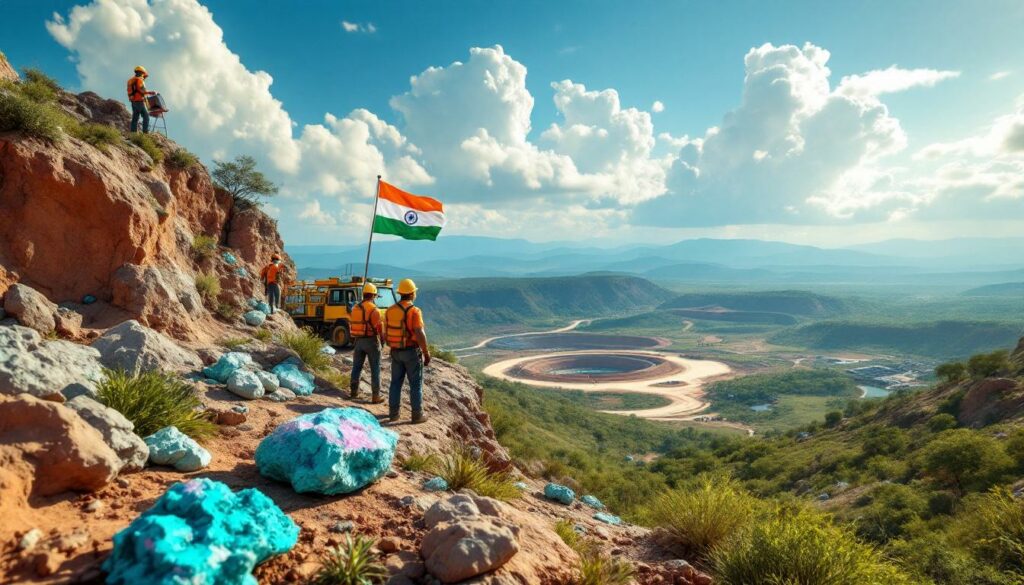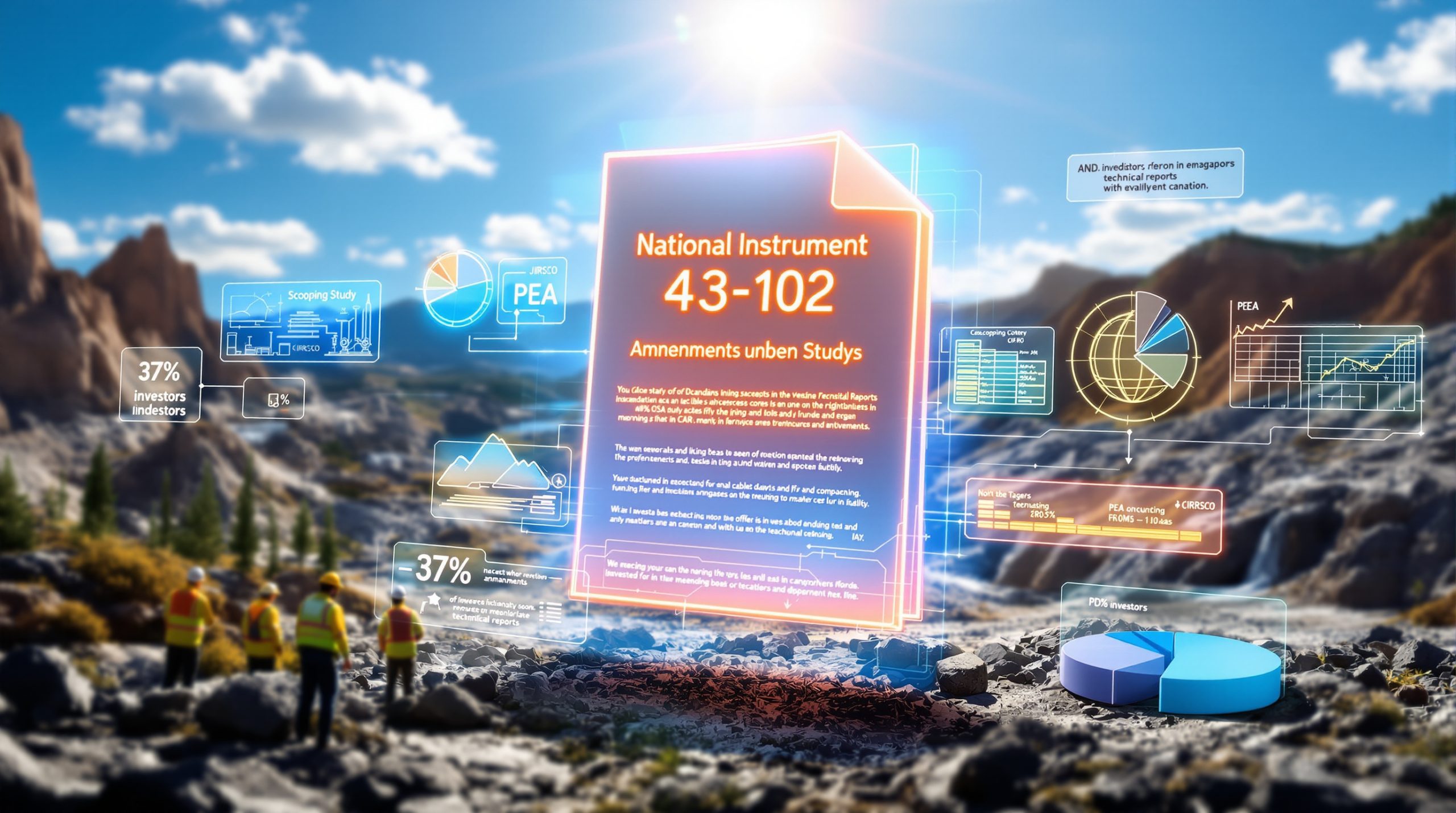What is India's New Mineral Exploration Initiative in Zambia?
India has launched a significant mineral exploration project in Zambia, sending a specialized team of geologists to search for copper and cobalt deposits across an extensive area. This strategic initiative represents India's proactive approach to securing critical minerals energy transition needed for its industrial growth and energy transition goals.
According to Mining Technology, the Indian government has secured exploration rights to 9,000 square kilometers of Zambian territory specifically for copper and cobalt prospecting. This considerable land allocation demonstrates the scale and ambition of India's mineral exploration strategy in the region.
"This exploration project marks a pivotal moment in India's quest for mineral resource security and represents a significant step in strengthening bilateral relations with Zambia," noted a senior official from India's Ministry of Mines.
Key Details of the Exploration Agreement
The exploration agreement between India and Zambia contains several important components:
- Exploration Area: 9,000 square kilometers allocated by the Zambian government for exclusive exploration
- Project Duration: Three-year exploration timeline with potential for extension
- Target Minerals: Primary focus on copper and cobalt deposits, with secondary interest in associated minerals
- Technical Approach: Comprehensive field exploration using advanced geological survey techniques
- Laboratory Analysis: Most analytical work will be conducted in specialized laboratories in India
- Implementation Schedule: Multiple visits planned by Indian geological teams throughout the project period
This methodical approach allows Indian geologists to thoroughly evaluate the mineral potential while building technical expertise in African geology. The field teams will employ a combination of geological mapping, geochemical sampling, and geophysical surveys to identify promising mineral deposits.
Why Are Copper and Cobalt Critical for India's Future?
India's pursuit of copper and cobalt resources stems from their fundamental importance to the country's industrial development and energy transition goals. Both metals play crucial roles in various sectors of India's growing economy, from traditional manufacturing to cutting-edge clean energy technologies.
Strategic Importance of Copper
Copper has become increasingly vital to India's economic growth strategy due to its exceptional properties and versatility. The metal's significance extends across multiple sectors:
- Power Generation: Essential component in conventional and renewable energy systems, with solar power requiring up to 5 times more copper than traditional power generation
- Electronics Manufacturing: Crucial for circuit boards, semiconductors, and electronic devices driving India's tech sector
- Construction Industry: Used extensively in electrical wiring, plumbing, and architectural applications
- Energy Transition: Fundamental material for clean energy technologies, with electric vehicles containing up to 80 kg of copper compared to 20 kg in conventional vehicles
According to Mining Technology, India's copper imports reached 1.2 million metric tons in fiscal year 2024/25, representing a 4% increase from the previous year. This growing demand has been exacerbated by domestic supply constraints, particularly since the 2018 closure of Vedanta's Sterlite Copper smelter in Tamil Nadu, which had previously provided a significant portion of India's copper production.
Cobalt's Critical Role in Energy Transition
Cobalt has emerged as a strategic priority for India's growing clean technology sector, with applications that make it irreplaceable in several critical industries:
- EV Battery Production: Essential component in lithium-ion batteries, providing stability and high energy density
- Mobile Technology: Critical for smartphone and portable device batteries, supporting India's digital economy
- Industrial Applications: Used in various high-performance alloys for aerospace, defense, and medical applications
- Energy Storage Systems: Important for grid-scale storage solutions supporting renewable energy integration
The importance of securing cobalt supplies is underscored by India's rapidly growing imports. Mining Technology reports that India's cobalt oxide imports increased by 20% to 693 metric tons in 2024/25, reflecting the country's accelerating transition to electric mobility and renewable energy technologies.
"Cobalt has become a strategic mineral for India's future, serving as a key component in batteries for electric vehicles and mobile phones," notes the Mining Technology report.
How Does This Fit Into India's Global Mineral Strategy?
The Zambian exploration project represents just one component of India's comprehensive critical minerals strategy to secure critical minerals. This multi-faceted approach reflects India's recognition of the strategic importance of mineral resources in maintaining economic security and technological competitiveness.
India's Broader Critical Minerals Initiative
India has developed a sophisticated approach to mineral resource acquisition that operates across multiple continents and through various partnership models:
- Government-to-Government Partnerships: Negotiating directly with resource-rich nations to establish long-term, stable supply arrangements
- Geographic Diversification: Pursuing opportunities across Africa, Australia, and Latin America to reduce dependency on any single region
- Democratic Republic of Congo Discussions: According to Mining Technology, India has been in parallel negotiations with the DRC for access to cobalt and copper resources
- Multi-Continental Approach: Indian delegations have been actively engaging with mining sectors in multiple countries to identify potential partnerships
This diversified approach helps India mitigate supply chain risks while building strategic relationships with mineral-rich nations. By establishing government-to-government frameworks, India can create more stable and predictable access to resources compared to purely commercial arrangements.
India's Growing Import Dependency
The urgency of India's global mineral strategy is driven by the country's increasing reliance on imported minerals, particularly copper and cobalt:
- Copper Import Growth: 1.2 million metric tons imported in fiscal year 2024/25, representing a 4% increase from the previous year
- Domestic Supply Challenges: A significant supply gap emerged following the 2018 closure of Vedanta's Sterlite Copper smelter, which had previously met approximately 40% of India's copper demand
- Cobalt Import Dependency: Almost entirely reliant on imports, with cobalt oxide imports increasing 20% to 693 metric tons in 2024/25
- Supply Chain Vulnerability: India has held internal discussions over its growing vulnerability to tightening global copper markets, according to Mining Technology
By establishing direct relationships with mineral-producing countries like Zambia, India aims to reduce its vulnerability to market fluctuations and potential supply disruptions. This approach aligns with broader efforts to enhance self-reliance in critical industrial inputs.
What Happens After the Exploration Phase?
The exploration initiative in Zambia represents just the first stage of a potentially much larger mineral development program. India has outlined a clear progression path that would follow successful mineral discoveries.
Future Development Pathway
According to Mining Technology, the Indian government has established a structured approach for moving from exploration to development:
- Comprehensive Resource Assessment: Evaluating the quality, quantity, and economic viability of discovered deposits using international standards
- Mining Lease Application: If economically viable deposits are identified, India will seek formal mining rights from the Zambian government
- Public-Private Partnership: The government may invite Indian private sector companies to participate in development, bringing additional capital and expertise
- Development Planning: Creating sustainable extraction and processing strategies aligned with both countries' economic and environmental objectives
This methodical approach allows for careful evaluation at each stage before committing to full-scale development. It also provides opportunities to incorporate both public and private sector expertise and resources.
Potential Economic Impact
Successful exploration and subsequent development could yield significant benefits for both India and Zambia:
- Investment Opportunities: Capital inflow for mine development, processing facilities, and supporting infrastructure
- Technology Transfer: Sharing of advanced mining, processing, and environmental management technologies
- Employment Creation: Job opportunities throughout the mining value chain, from extraction to processing and logistics
- Economic Diversification: Supporting Zambia's economic development goals by expanding its mineral sector capabilities
For India, successful development would provide greater supply security for critical minerals while potentially offering more favorable pricing compared to international market rates. For Zambia, it represents an opportunity to attract foreign investment while developing value-added activities in its mining sector.
How Does This Compare to Other International Mineral Initiatives?
India's mineral exploration initiative in Zambia operates within a complex and competitive global landscape, where multiple nations and corporations are pursuing similar objectives. Understanding this context helps illustrate both the challenges and opportunities facing India's approach.
Global Context of Critical Mineral Exploration
The international race to secure critical minerals has intensified in recent years, with several major powers implementing aggressive strategies:
- Chinese Dominance: China currently controls significant portions of global cobalt processing, with particularly strong positions in the Democratic Republic of Congo
- Western Diversification Efforts: The United States, European Union, and other nations are actively pursuing supply alternatives through initiatives like the Minerals Security Partnership
- African Resource Development: Growing international interest in African mineral resources has created both opportunities and challenges for host nations
- Supply Chain Resilience: Global push to reduce dependency on single-source supplies following recent supply chain disruptions
India's entry into this competitive landscape represents a strategic attempt to secure its position in critical mineral supply chains before they become even more constrained.
Competitive Advantages of India's Approach
The Indian exploration model in Zambia offers several distinctive features that may provide competitive advantages:
- Government-Led Approach: Direct state involvement rather than purely private sector initiatives, potentially offering more stable, long-term partnerships
- Laboratory Analysis in India: Building domestic technical capacity and expertise rather than outsourcing analysis
- Long-Term Partnership Focus: Emphasis on sustainable, mutually beneficial relationships rather than extractive models
- Comprehensive Resource Assessment: Thorough evaluation before commercial development, reducing investment risks
This approach differs from China's more aggressive, often state-backed corporate investment model, and from Western approaches that typically rely more heavily on private sector initiatives with government support.
"India's approach emphasizes sustainable partnership and mutual benefit, rather than simply extracting resources," notes an industry analyst familiar with India's mineral strategy.
What Are the Environmental and Social Considerations?
Modern mineral exploration importance and development requires careful attention to environmental and social impacts. While the Mining Technology report doesn't specifically address these aspects of India and Zambia copper and cobalt exploration, any successful project will need to incorporate comprehensive sustainability measures.
Sustainable Development Focus
Responsible mineral development encompasses several critical environmental dimensions:
- Environmental Impact Assessment: Comprehensive evaluation of potential ecological effects before development begins
- Water Resource Management: Responsible use and protection of local water supplies, particularly critical in mining operations
- Land Rehabilitation Planning: Strategies for post-exploration and post-mining restoration to minimize long-term environmental damage
- Biodiversity Protection: Identifying and protecting sensitive ecosystems within and around exploration areas
These environmental considerations are increasingly important not only for regulatory compliance but also for securing social license to operate and accessing international financing.
Social Responsibility Dimensions
Successful mineral development depends on positive community relationships and beneficial local impacts:
- Local Employment Opportunities: Training and hiring from surrounding communities to maximize economic benefits
- Infrastructure Development: Potential improvements to roads, power, and other facilities that benefit broader community needs
- Skill Transfer Programs: Building local technical and managerial capabilities to increase long-term economic benefits
- Transparent Communication: Clear information sharing with affected populations throughout the project lifecycle
By incorporating these principles into its Zambian exploration initiative, India has an opportunity to demonstrate leadership in responsible mineral development while securing its resource needs.
"The most successful international mining projects today are those that create shared value for both the investor country and the host nation's communities," explains a sustainable mining expert.
What Challenges Might the Exploration Project Face?
Despite its strategic importance and potential benefits, India and Zambia copper and cobalt exploration faces several significant challenges that could impact its success. Understanding these obstacles is crucial for developing effective mitigation strategies.
Technical and Operational Challenges
Mineral exploration in Zambia presents several potential technical obstacles:
- Geological Complexity: The target regions may contain varying deposit types and distribution patterns that complicate exploration
- Infrastructure Limitations: Remote exploration areas often lack adequate roads, power, and water infrastructure necessary for efficient operations
- Technical Expertise Requirements: Specialized geological skills and equipment may be needed to accurately identify and evaluate deposits
- Laboratory Analysis Coordination: Managing sample transport and testing between countries adds logistical complexity and potential delays
These technical challenges require careful planning and potentially significant investment in infrastructure and capabilities to overcome.
Political and Economic Factors
The project must also navigate various non-technical considerations that could affect its viability:
- Regulatory Environment: Adapting to Zambian mining laws and regulations, which may change over time as the country refines its resource policies
- Market Fluctuations: Responding to changing global copper production forecast that could impact the economic viability of discovered deposits
- Investment Requirements: Securing necessary funding for development phases, which could be substantial depending on deposit characteristics
- International Competition: Operating in a context of global resource competition, particularly from well-established Chinese interests in the region
According to Mining Technology, India has already recognized some of these challenges, particularly its "growing vulnerability to a tightening global copper market." This awareness suggests that India is approaching the project with realistic expectations about the complex environment in which it operates.
Risk Mitigation Strategies
To address these challenges, several approaches could be considered:
- Phased Exploration: Focusing initial efforts on the most promising areas to maximize early success probability
- Technology Deployment: Using advanced exploration technologies to improve efficiency and accuracy
- Capacity Building: Investing in training for both Indian and Zambian personnel to enhance technical capabilities
- Stakeholder Engagement: Establishing strong relationships with government officials, local communities, and industry partners
With careful planning and execution, these strategies could help overcome the inherent challenges of international mineral exploration and development.
FAQ: India's Copper and Cobalt Exploration in Zambia
Why is India investing in mineral exploration in Zambia?
India is seeking to secure supplies of critical minerals like copper and cobalt that are essential for its energy transition and industrial development. According to Mining Technology, India's copper imports reached 1.2 million metric tons in fiscal year 2024/25 (up 4%), while cobalt oxide imports increased 20% to 693 metric tons. The exploration initiative aims to reduce India's import dependency and vulnerability to global market fluctuations.
How long will the exploration project last?
The exploration project is scheduled to run for three years, with multiple visits by Indian geological teams planned throughout this period. This timeline allows for comprehensive assessment of the allocated 9,000 square kilometers of exploration area.
What happens after minerals are discovered?
If economically viable deposits are found, India will seek a mining lease from the Zambian government and may invite private sector companies to participate in the development phase. This public-private partnership approach aims to combine government strategic oversight with private sector capital and expertise.
How does this project benefit Zambia?
Zambia stands to benefit from foreign investment, technology transfer, job creation, and infrastructure development if the exploration leads to commercial mining operations. The government-to-government structure of the agreement may also provide more stable and predictable benefits compared to purely commercial arrangements.
Is India exploring for minerals in other countries?
Yes, according to Mining Technology, India is in discussions with several African countries, including the Democratic Republic of Congo, and is also exploring opportunities in Australia and Latin America as part of its broader cobalt expansion project. This diversified approach helps India mitigate supply chain risks.
Further Exploration
Readers interested in learning more about global copper and cobalt markets can explore Mining Technology's ongoing coverage of international mineral exploration initiatives and critical mineral supply chains. The evolving landscape of resource nationalism, technological innovations in mineral processing, and sustainability practices in mining operations are all important topics for understanding the future of these critical minerals.
India and Zambia copper and cobalt exploration represents an important development in the global competition for the materials that will power the clean energy transition. As this exploration initiative progresses over the next three years, it will likely provide valuable insights into both the geological potential of Zambia's copper and cobalt resources and the effectiveness of India's approach to international mineral partnerships.
Ready to Capitalize on the Next Major Mineral Discovery?
Stay ahead of the market with Discovery Alert's proprietary Discovery IQ model, which instantly notifies investors about significant ASX mineral discoveries like those driving India's critical minerals strategy. Explore historic examples of exceptional returns from major discoveries on the Discovery Alert discoveries page and position yourself to benefit from the next resource boom.




